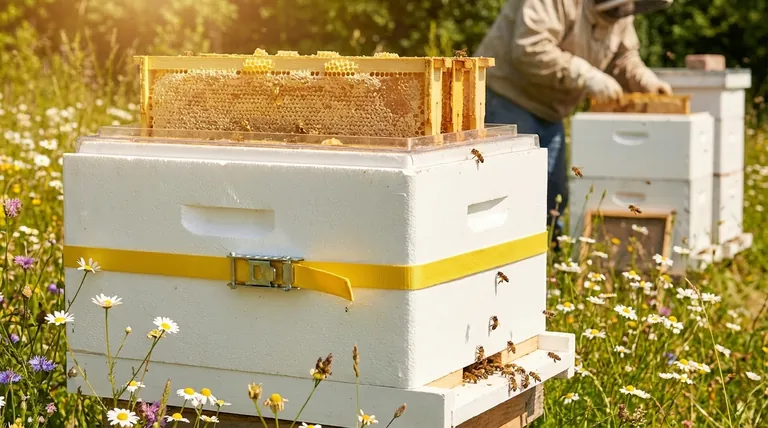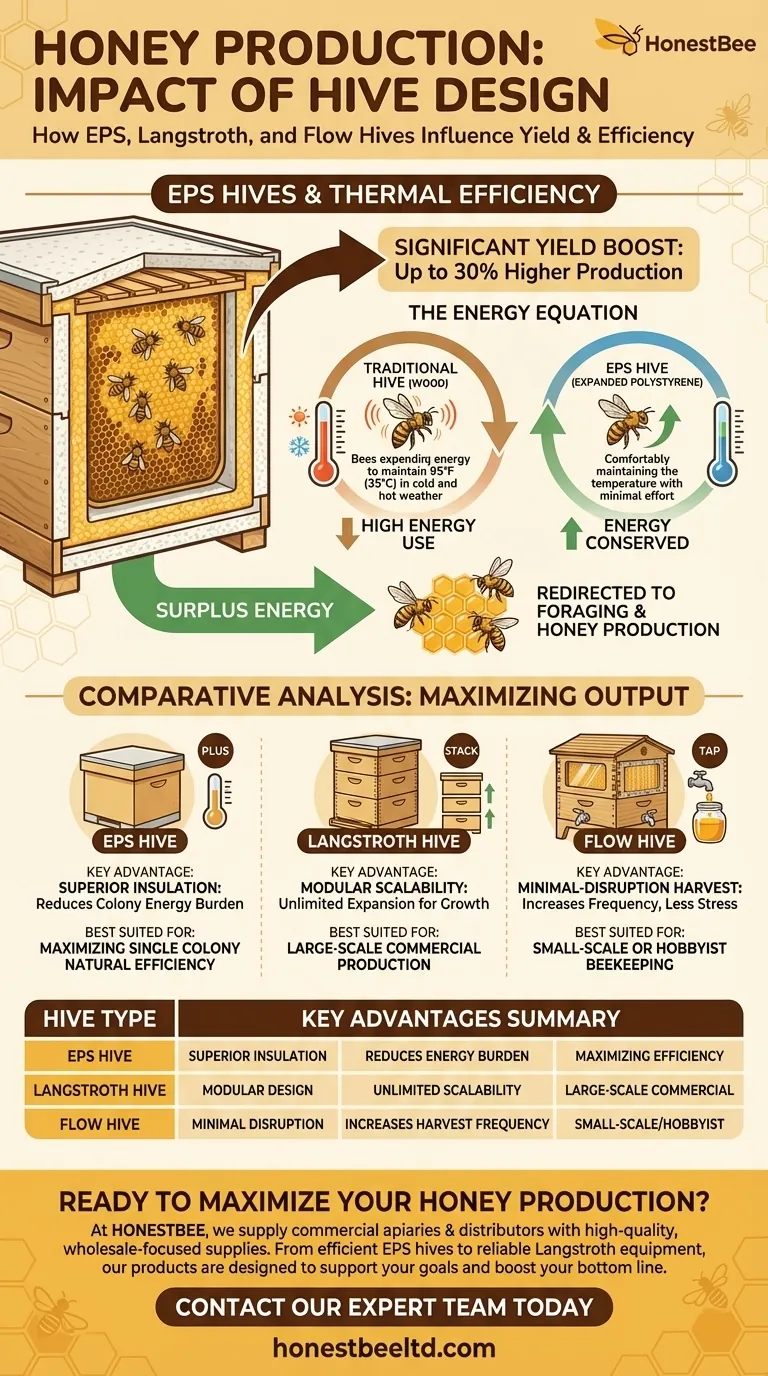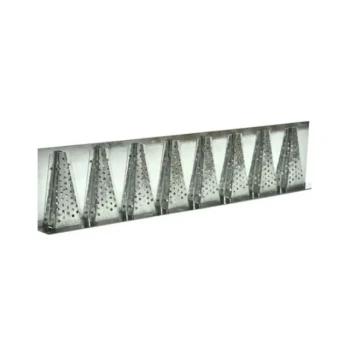In short, yes. Expanded Polystyrene (EPS) bee hives can significantly increase honey production, with some commercial beekeepers reporting yields up to 30% higher than with traditional wooden hives. This boost is primarily due to the superior insulation of the material, which helps the bee colony conserve energy that would otherwise be spent on temperature regulation.
The type of hive you choose directly impacts honey yield, but the "best" hive depends on your goal. While EPS hives increase production through thermal efficiency, other designs like Langstroth or Flow Hives boost yield through scalability or harvesting efficiency.

How Insulation Directly Impacts Honey Production
The core advantage of an EPS hive is its ability to reduce the energy burden on the colony. This has a direct and positive effect on the bees' capacity to produce honey.
The Energy Equation: Bees and Temperature Control
A honeybee colony works tirelessly to maintain a stable internal hive temperature, typically around 95°F (35°C), to raise their brood. In colder weather, they must expend enormous amounts of energy by clustering and vibrating their wing muscles to generate heat.
The EPS Advantage: Superior Thermal Efficiency
EPS is an excellent insulator. Hives made from this material act like a thermos, helping the bees keep the hive warm in the winter and cool in the summer with far less effort.
This thermal stability means the colony consumes fewer of its own honey stores to survive the winter and requires less energy for climate control year-round.
Redirecting Energy to Foraging and Production
The energy saved from temperature regulation is not lost. Instead, the bees can redirect this surplus energy into other vital activities, most notably foraging for nectar and producing honey.
With more energy available for these tasks, the colony can build up its honey stores more quickly and efficiently.
Beyond Insulation: Other Hive Factors Driving Yield
While the insulation of EPS is a powerful factor, it isn't the only hive characteristic that influences honey production. Different hive designs leverage different principles to maximize output.
Hive Scalability: The Langstroth Model
The traditional wooden Langstroth hive is renowned for its effectiveness in maximizing honey output, primarily due to its modular design.
A beekeeper can easily add more boxes (supers) to the hive as the colony grows and fills them with honey. For anyone looking to produce large quantities for sale, this near-unlimited scalability is a massive advantage.
Extraction Efficiency: The Flow Hive Innovation
The Flow Hive increases yield by revolutionizing the harvesting process. Its design allows for honey extraction with minimal disruption to the bees and without opening the hive.
This process is faster and less intrusive, enabling more frequent harvests. The bees can continue their work uninterrupted, leading to higher productivity, especially for small-scale or hobbyist beekeepers.
Understanding the Trade-offs
No single hive design is universally superior. Each comes with a distinct set of trade-offs that make it better suited for different goals and scales of operation.
EPS Hives: A Focus on Efficiency
The primary benefit of EPS is thermal performance. While this boosts yield, the beekeeper must still perform traditional inspections and honey extraction, which requires time and labor.
Langstroth Hives: Labor and Equipment Costs
Although Langstroth hives are the standard for commercial production due to their scalability, they require more work. Honey extraction is a labor-intensive process that demands additional, often expensive, equipment.
Flow Hives: Best for Small-Scale Operations
The Flow Hive offers a brilliant, no-fuss option for producing honey on a small scale. However, its design may be less practical or cost-effective for beekeepers aiming for large-scale commercial production compared to the stackable Langstroth.
Making the Right Choice for Your Goal
The decision to use EPS, Langstroth, Flow Hives, or another type should be driven by your specific objectives as a beekeeper.
- If your primary focus is maximizing a colony's natural productivity: An EPS hive's thermal efficiency provides a significant advantage by reducing the colony's energy burden.
- If your primary focus is building a large-scale commercial operation: The proven scalability and modularity of the Langstroth hive is the industry standard for maximizing volume.
- If your primary focus is simplified, small-scale hobby beekeeping: The low-disruption harvesting and ease of use of a Flow Hive can lead to more frequent, less stressful honey collection.
Ultimately, choosing the right hive means matching the design's strengths to your specific beekeeping goals.
Summary Table:
| Hive Type | Key Advantage for Honey Production | Best Suited For |
|---|---|---|
| EPS Hive | Superior insulation reduces colony energy burden | Maximizing a single colony's natural efficiency |
| Langstroth Hive | Modular design allows for unlimited scalability | Large-scale commercial honey production |
| Flow Hive | Minimal-disruption harvesting increases frequency | Small-scale or hobbyist beekeeping |
Ready to maximize your honey production?
At HONESTBEE, we supply commercial apiaries and beekeeping equipment distributors with the high-quality, wholesale-focused supplies they need to succeed. Whether you're looking to upgrade to efficient EPS hives or scale your operation with reliable Langstroth equipment, our products are designed to support your goals and boost your bottom line.
Contact our expert team today to discuss your specific needs and discover how we can help your business thrive.
Visual Guide

Related Products
- Professional Galvanized Hive Strap with Secure Locking Buckle for Beekeeping
- Nicot Queen Rearing Kit for Beekeeping and Grafting in Nicot System
- Professional Reversible Beehive Hive Entrance
- Jenter Queen Rearing Kit Complete Set for Bee Breeding
- No Grafting Queen Rearing Kit: System for Royal Jelly Production and Queen Rearing
People Also Ask
- Why are hive straps important for beekeepers? Secure Your Hives Against Wind, Predators & Transport
- What are the two styles of hive straps? Choose the Right Strap for Your Hive Security
- How can beekeepers secure the top cover of a hive? Protect Your Colony from Wind and Weather
- What is the advantage of using cam buckle straps? Secure Your Load Fast with Simple, Safe Tensioning
- Can straps with hook ends be used for beehives? A Guide to Secure Hive Management



















